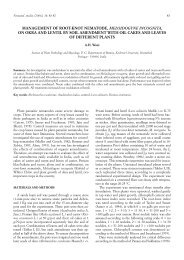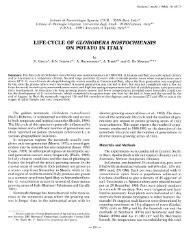effect of paecilomyces lilacinus and beauveria bassiana in ...
effect of paecilomyces lilacinus and beauveria bassiana in ...
effect of paecilomyces lilacinus and beauveria bassiana in ...
Create successful ePaper yourself
Turn your PDF publications into a flip-book with our unique Google optimized e-Paper software.
.Centrai Agricultural Researcb Institute, P.O. Box 11, Peradeniya, Sri Lanka <strong>and</strong><br />
.. Faculty o/ Agriculture, University o/ Peradeniya, Sri Lanka<br />
Nematol. medito (1994). 22: 87-88<br />
EFFECT OF PAECILOMYCES LILACINUS AND BEAUVERIA BASSIANA IN<br />
CONTROLLING MELOIDOGYNE INCOGNITA ON TOMATO IN SRI LANKA<br />
by<br />
H.M.R.K. EKANAYAKE. <strong>and</strong> N. J.<br />
]AYASUNDARA ..<br />
Summary. 111e efficacy <strong>of</strong> two nernatophagous fungi, Paecilomyces <strong>lilac<strong>in</strong>us</strong> <strong>and</strong> Beauveria <strong>bassiana</strong> far lise as biocontrol agents aga<strong>in</strong>st<br />
Meloidogyne <strong>in</strong>cognita on tornato was evaluated <strong>and</strong> compared with the nematicide carb<strong>of</strong>uran. Carb<strong>of</strong>uran <strong>and</strong> P. <strong>lilac<strong>in</strong>us</strong> controlled the<br />
root-knot nematode <strong>and</strong> <strong>in</strong>creased the growth <strong>of</strong> plants; B. <strong>bassiana</strong> was less <strong>effect</strong>ive.<br />
Tornato, Lycopersicon esculentum Mill., is an attractive<br />
cash crop <strong>and</strong> provides a potential source for rural developrnent<br />
<strong>in</strong> the CentraI region <strong>of</strong> Sci Lanka. However, it is<br />
subject to attack by root-knot nernatodes, Meloidogyne<br />
spp., with crop losses <strong>of</strong> up to 490/0 (Larnberti et al., 1980).<br />
Nernaticides bave been <strong>effect</strong>ive for the control <strong>of</strong> rootknot<br />
nernatodes on tornato but they afe expensive, especially<br />
for srnall scale farmers. Biological control us<strong>in</strong>g fungaI<br />
antagonists is a less expensive alternative.<br />
S<strong>in</strong>ce the discovery <strong>of</strong> Paecilomyces <strong>lilac<strong>in</strong>us</strong> (Thorn.)<br />
Sarnson for the control <strong>of</strong> root.knot nernatodes (Jatala,<br />
1981) several <strong>in</strong>vestigations bave been undertaken to evaluate<br />
its use with econornically important crops. Beauveria<br />
<strong>bassiana</strong> Bales is an entornophagous fungus, which produces<br />
tox<strong>in</strong>s such as beauveric<strong>in</strong> <strong>and</strong> has been used for<br />
the control <strong>of</strong> larvae <strong>of</strong> some <strong>in</strong>sect pests (D<strong>in</strong>gra <strong>and</strong> S<strong>in</strong>clair,<br />
1985).<br />
The present study cornpared the two fungi, P. <strong>lilac<strong>in</strong>us</strong><br />
<strong>and</strong> B. <strong>bassiana</strong>, with the chemical nernaticide carb<strong>of</strong>uran<br />
for the control <strong>of</strong> M. <strong>in</strong>cognita (K<strong>of</strong>oid etWhite) Chitw. on<br />
tornato.<br />
Materials <strong>and</strong> methods<br />
A culture <strong>of</strong> M. <strong>in</strong>cognita was ma<strong>in</strong>ta<strong>in</strong>ed on tornato<br />
cv. Katugastota <strong>in</strong> a planthouse <strong>and</strong> eggs <strong>and</strong> juveniles<br />
were obta<strong>in</strong>ed by the NaOCL method (Hussey <strong>and</strong> Barker,<br />
1973). The fungi, P. <strong>lilac<strong>in</strong>us</strong> <strong>and</strong> B. <strong>bassiana</strong> were<br />
ota<strong>in</strong>ed from the lntemational Potato Centre, Pero, <strong>and</strong><br />
cultured <strong>in</strong> sterilized seed paddy at a room temperature <strong>of</strong><br />
25:f:2 °C far three weeks.<br />
- R7-<br />
Fifty cIay pots were fllled with 800 mi <strong>of</strong> heat steriIized<br />
s<strong>and</strong>y soil. Forty <strong>of</strong> the pots were each <strong>in</strong>ocuiated with<br />
2000 eggs <strong>and</strong>/or juveniles <strong>of</strong> M. <strong>in</strong>cognita. Ten <strong>of</strong> these<br />
pots were then <strong>in</strong>ocuiated with P. <strong>lilac<strong>in</strong>us</strong> at the rate <strong>of</strong><br />
2g coionized seed paddy per pot; a further ten pots were<br />
similarIy <strong>in</strong>ocuiated with B. <strong>bassiana</strong>; <strong>and</strong> ten <strong>of</strong> the pots<br />
each received 0.5 g <strong>of</strong> 3% carb<strong>of</strong>uran granules. AlI <strong>of</strong> the<br />
pots, <strong>in</strong>ciud<strong>in</strong>g the untreated controls, were pianted with a<br />
s<strong>in</strong>gle 18 dar oid tornato cv. Katugastota seed<strong>in</strong>g. The pots<br />
were arranged <strong>in</strong> a completely r<strong>and</strong>omized design <strong>in</strong> a<br />
pIanthouse with a dar temperature <strong>of</strong> 25:1:2 °C <strong>and</strong> a night<br />
temperature <strong>of</strong> 18:1:2 °c.<br />
The heights <strong>of</strong> pIants were measured at 30, 40, 50 <strong>and</strong><br />
60 days after <strong>in</strong>ocuiation with fungi <strong>and</strong> treatrnent with nematicide.<br />
The weights <strong>of</strong> the piant tops <strong>and</strong> the root gall<strong>in</strong>g<br />
<strong>in</strong>dex (TayIor <strong>and</strong> Sasser, 1978) were ascerta<strong>in</strong>ed at the<br />
end <strong>of</strong> the experiment.<br />
Results <strong>and</strong> discussion<br />
At 30 days after the beg<strong>in</strong>n<strong>in</strong>g <strong>of</strong> the experiment, the<br />
height <strong>of</strong> plants <strong>in</strong> pots treated with the fungi or carb<strong>of</strong>uran<br />
were significantly (P = 0.05) less than the un<strong>in</strong>oculated<br />
control or the treatment with nematodes only (Table I).<br />
However, at 40 days the height <strong>of</strong> plants <strong>in</strong> each <strong>of</strong> the<br />
treatments was similar <strong>and</strong> at 60 days (the end <strong>of</strong> the experimenO<br />
the height <strong>of</strong> the plants <strong>in</strong> the two fungal treatments<br />
was significantly greater than <strong>in</strong> the other treatments.<br />
There was a significant <strong>effect</strong> <strong>of</strong> M. <strong>in</strong>cognita on the<br />
top V:ieight <strong>of</strong> plants, which was 63% <strong>of</strong> the un<strong>in</strong>oculated
TABLE I - Effect oJ treatrnents on beigbt oJ tornato plants<br />
grown <strong>in</strong> pots <strong>in</strong>oculated witb Meloidogyne <strong>in</strong>cognita.<br />
rreatment<br />
Paecilomyces <strong>lilac<strong>in</strong>us</strong><br />
+ Nematode<br />
Beauveria <strong>bassiana</strong><br />
+ Nematode<br />
Carb<strong>of</strong>uran + Nematode<br />
Nematode only<br />
Un<strong>in</strong>oculated contrai<br />
Mean height <strong>of</strong> plants (cm)<br />
Days after <strong>in</strong>oculation<br />
30 40 50 60<br />
45 a 70 a 87 a 95 a<br />
46 a<br />
47 a<br />
54 b<br />
55 b<br />
71 a<br />
73 a<br />
68a<br />
73 a<br />
82 a<br />
83 a<br />
74 b<br />
82 a<br />
94 a<br />
84b<br />
79 c<br />
87b<br />
Values followed by the same lener <strong>in</strong> each column afe not significantly<br />
different far p ~ 0.05 accord<strong>in</strong>g to Duncan's multiple range<br />
test.<br />
TABLE Il - Effect oJtreatments on plant top weight <strong>and</strong> rootknot<br />
<strong>in</strong>dex oJ tornato plants grown <strong>in</strong> pots <strong>in</strong>oculated with<br />
Meloidogyne <strong>in</strong>cognita. Literature cited<br />
Treatment<br />
Paecilomyces <strong>lilac<strong>in</strong>us</strong><br />
+ Nematode<br />
Beauveria <strong>bassiana</strong><br />
+ Nematode<br />
Carb<strong>of</strong>uran + Nematode<br />
Nematode only<br />
Un<strong>in</strong>ocuiated contrai<br />
Mean top weight Mean roat-knat<br />
(g) <strong>in</strong>dex<br />
88 a<br />
70 b<br />
92 a<br />
58 c<br />
92 a<br />
2.8b<br />
3.3 b<br />
0.8 c<br />
4.5 a<br />
O c<br />
Values followed by the same letter <strong>in</strong> each column afe not significantly<br />
different far p = 0.05 accord<strong>in</strong>g to Duncan's multiple range<br />
test.<br />
Accepted for publication on 1 March 1994<br />
- 88 -<br />
contraI (Table Il). The top weights <strong>of</strong> plants treated with<br />
P. <strong>lilac<strong>in</strong>us</strong> or carb<strong>of</strong>uran were similar to those <strong>of</strong> the un<strong>in</strong>oculated<br />
contraI <strong>and</strong> alI treatrnents were significantly<br />
greater than the treatment with nematodes alone. Carb<strong>of</strong>uranwas<br />
the rnost <strong>effect</strong>ive treatrnent far the contraI <strong>of</strong> M.<br />
<strong>in</strong>cognita, as rneasured by the root-knot <strong>in</strong>dex (Table Il)<br />
but bolli fungi also had a significant <strong>effect</strong>.<br />
The experiment <strong>in</strong>dicates that P. <strong>lilac<strong>in</strong>us</strong> could be an<br />
<strong>effect</strong>ive rneans <strong>of</strong> controll<strong>in</strong>g M. <strong>in</strong>cognita on tornato <strong>and</strong><br />
a substitute far nernaticides such as carb<strong>of</strong>uran.<br />
DINGRA D. O. <strong>and</strong> SINCLAIR B. J., 1985. Basic plant pathology methods.<br />
CRS Press Inc. Florida, pp. 245.<br />
HussEY R. S. <strong>and</strong> BARKER K. R., 1973. A comparison <strong>of</strong> methods <strong>of</strong><br />
collect<strong>in</strong>g <strong>in</strong>ocula <strong>of</strong> Meloidogyne spp., Plant Disease Rep., 57:<br />
1025-1028.<br />
JATALA P., 1981. Biological control <strong>of</strong> Meloidogynespp. Methodology<br />
far preparation far field <strong>in</strong>oculation. Proceed<strong>in</strong>gs <strong>of</strong> the<br />
Third Research Plann<strong>in</strong>g Conference on root-knot nernatodes,<br />
Meloidogyne spp. <strong>in</strong> Jakarta, Indonesia. July, 1981: pp. 20-24.<br />
LAMBERll F., EKANAYAKE H.M.R.K., ZAcHEO F. <strong>and</strong> ABEYKOON M. B.,<br />
1980. Yield response <strong>of</strong> tornato to nernaticidal treatments <strong>in</strong><br />
soil <strong>in</strong>fested by Meloidogyne javanica <strong>in</strong> Sri Lanka. Nematol.<br />
medit., 8: 131-135.<br />
TAYIOR A. L. <strong>and</strong> SASSER J. N., 1978. Biology, Identification <strong>and</strong><br />
contrai 01 root-knot nematodes (Meloidogyne spp.) Coop.<br />
Pubi. Dep. Plant Pathol., North Carol<strong>in</strong>a State Univ., <strong>and</strong> U.S.<br />
Agency Int. Dev., Raleigh, N.C. 111 pp.




